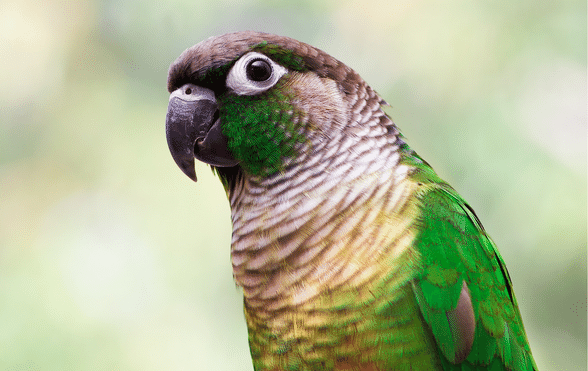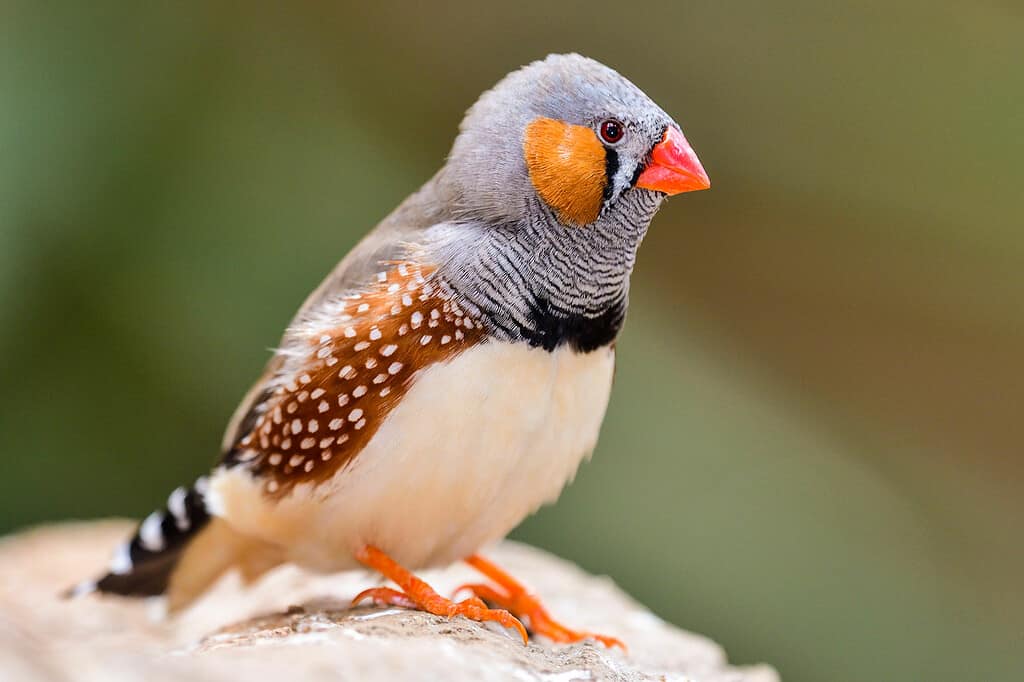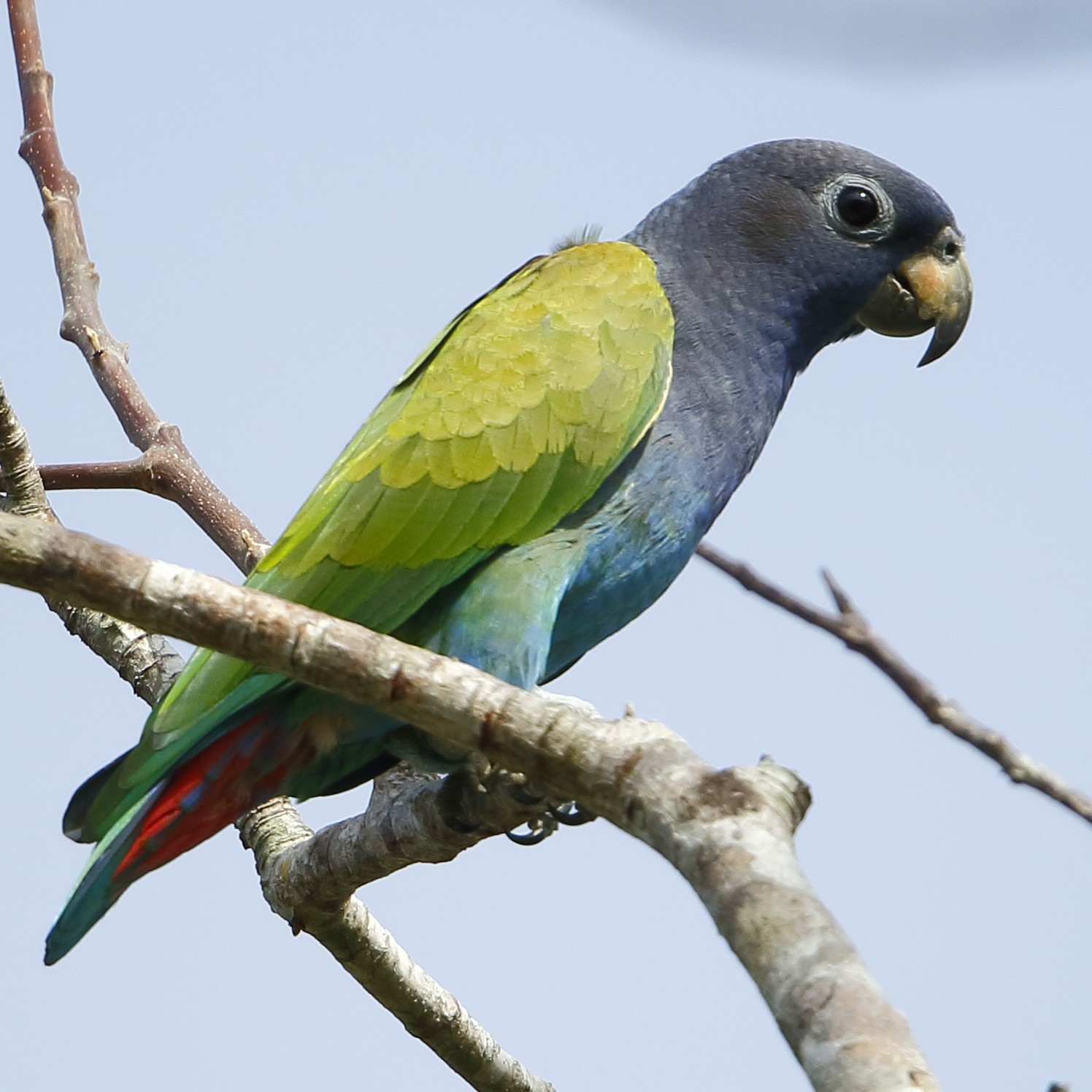Here’s a guide featuring the top 10 beginner-friendly birds. Read about their appearance, size, and temperament.
1. Budgie

- Appearance & Size: About 7–8 inches long, wild-type budgies are green and yellow; captive color mutations include blue, white, and pastel shades.
- Behavior Benefits: Extremely social, trainable, and often able to mimic human speech. Budgies are playful and bond easily with owners.
- Why They’re Beginner-Friendly: Manageable size, affectionate nature, low noise, and budget-friendly.
2. Cockatiel

- Appearance & Size: Approximately 12–13 inches in length with crest, grey body, yellow face, and orange cheek patches; bred color mutations include pied, lutino, and white-faced.
- Behavior Benefits: Gentle, affectionate, and often enjoy whistling or light speech. Readable cues (like crest movement) help beginners respond well.
- Ideal For: Families and new bird owners seeking gentle interaction and easy handling.
3. Green-Cheeked Conure

- Appearance & Size: About 10 inches long, weighing 60–80 g. Plumage: mostly green with maroon belly, blue flight feathers, and red/orange cheeks in wild type; many color mutations exist.
- Behavior Benefits: Affectionate, playful, and clever—able to learn tricks; quieter than other conures.
- Why They’re Good for First-Time Owners: Energetic and engaging companions, ideal for hands-on bonding (though require plenty of mental stimulation).
4. Canary

- Appearance & Size: Small—5–6 inches long, weighing ~15–20 g. Smooth shape, short beak; colors include yellow, orange, and mixed patterns depending on breed.
- Behavior Benefits: Low-maintenance and low-interaction; best for observing. Male canaries produce melodic singing rather than talking.
- Great For: People who want a peaceful, musical pet without handling responsibilities.
5. Zebra Finch

- Appearance & Size: Tiny—about 4–5 inches, slender with gray or brown bodies, orange cheeks in males, and white “zebra stripes” in females. No image shown above.
- Behavior Benefits: Always active and social; happiest in pairs/groups, they chirp and flutter in harmony.
- Ideal For: Bird lovers who enjoy observing group behavior rather than direct handling.
6. Lovebird

- Appearance & Size: 5–7 inches long, compact. Vibrant colors: green body, peach face, yellow and blue underparts (especially in the peach-faced variant).
- Behavior Benefits: Bold, affectionate, and energetic. Form strong bonds—especially if kept singly and handled often.
- Bonus: Known for playful antics—excellent choice for someone ready to dedicate time daily.
7. Parrotlet

- Appearance & Size: Around 5.5–6 inches long (14–15 cm), weighing ~35 g. Bright green body with yellow-face variants; males have vibrant blue patches (Wikipedia).
- Behavior Benefits: Tiny, but feisty and intelligent. Can be extremely affectionate when well-socialized.
- Good For: Owners seeking a compact companion with big personality.
8. Lineolated Parakeet (“Linnie”)

- Appearance & Size: About 6.5 inches (16 cm) long, 42–52 g. Green plumage striped with dark bars; underside wings often blue, peach-colored bill (Wikipedia).
- Behavior Benefits: Renowned for being calm, quiet, and easy to tame. Often tamer than budgies and good talkers without screeching.
- Ideal For: Quiet households or first-time owners wanting a mellow, social bird.
9. Pionus Parrot

- Appearance & Size: Medium size—about 11–12 inches long. Mostly green with a blue head and red under-tail feathers (blue-headed variant) (Wikipedia).
- Behavior Benefits: Affectionate but composed, not overly loud. Known for low-key companionship.
- Perfect For: People seeking a stable, moderately interactive parrot without high noise demands.
10. Bourke’s Parakeet

- Appearance & Size: Bourke’s Parakeets are about 7–8 inches long. They have soft pink bellies, a brownish back, and pastel blue highlights on the wings and tail. The “rosy” mutation is particularly popular in captivity.
- Behavior Benefits: Extremely calm and quiet, making them ideal for apartments. Not overly demanding of attention. Can become tame and affectionate with gentle handling. Tend to be more active at dawn and dusk, meaning they are peaceful most of the day.
- Why They’re Beginner-Friendly:
They combine gentle temperament, low noise, and minimal mess, making them one of the most underrated birds for beginners.
Behavior Comparison Table
| Bird | Size (inches) | Talk/Whistle | Affection Level | Noise Level | Social Needs |
|---|---|---|---|---|---|
| Budgie | 7–8 | Yes | High | Low | Moderate—best with human/company |
| Cockatiel | 12–13 | Yes | Very high | Mild | Needs daily interaction |
| Green-Cheek Conure | ~10 | Few words | Very high | Moderate | High mental & play needs |
| Canary | 5–6 | No | Low | Song (males) | Minimal – visual only |
| Zebra Finch | 4–5 | No | Low to none | Mild chirp | Needs groups |
| Lovebird | 5–7 | Simple sounds | High | Moderate | Social time required |
| Parrotlet | ~6 | Limited | High (if handled) | Low | Daily handling essential |
| Lineolated Parakeet | ~6.5 | Whistles/light speech | Moderate–High | Very low | Social with humans |
| Pionus Parrot | ~11–12 | Light | Moderate | Lower than amazons | Moderate household presence |
| Bourke’s Parakeet | 7-8 | Light | High | Low | Social |
Final Thoughts
Behavior and personality shape your experience more than size or color alone. Many of these birds—especially cockatiels, budgies, linnies, and conures—are ideal for first-time owners thanks to their trainability, affectionate nature, and moderate noise levels. Parrotlets and lovebirds are slightly more demanding, but immensely rewarding if you’re ready for the commitment.



